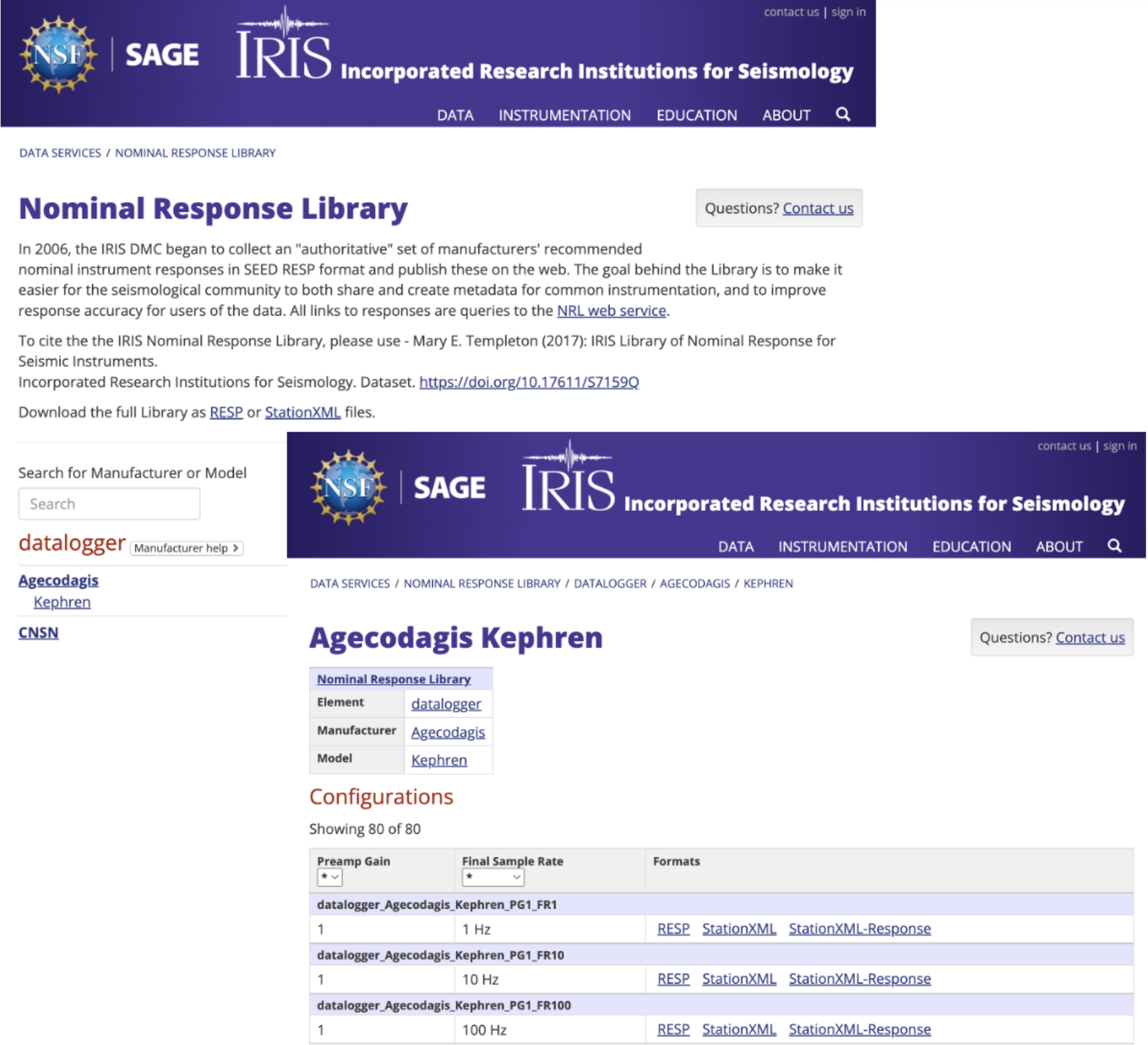The IRIS Nominal Response Web Service
In April 2022, IRIS released a new web service https://service.iris.edu/irisws/nrl/1/ to deliver instrument responses from the IRIS Nominal Response Library (NRL) (Templeton, 2017). The NRL is IRIS’ collection of manufacturers’ recommended nominal instrument responses and the new service delivers these responses in several formats, including StationXML, RESP, and a response-only subset of StationXML that we have named StationXML-Response. Another highlight of the service is the capability to combine multiple components, such as a sensor and datalogger, into a single, cascaded response.
Back in 2006, IRIS Data Services began compiling an authoritative set of instrument responses contributed by manufacturers with the goals of making it easier for the seismological community to create and share metadata for common instrumentation and improving response accuracy for data users. Instrument responses are organized in the NRL by instrument type, manufacturer, model, and hardware configuration. In the past, users and metadata creation software selected responses from a website or from a downloaded copy of the full Library. The new NRL web service allows for more flexible and programmatic access to the NRL response information, while also maintaining a new website access point and allowing a full Library download for local use. The full NRL download delivered by the web service (version 2) differs in convention from the NRL version 1 as described here.
At the time of this writing, the NRL includes nearly 23,000 responses from 35 sensor and 29 datalogger manufacturers, as well as recently added responses for integrated recorders and datalogger state of health channels.
Features of the NRL web service
In order to accommodate the needs of a broader community of instrument users and growing instrument designs going forward, the new NRL web service provides the following features:
- instrument response content browsing through
- its
catalogquery method (JSON, XML or text) - an interactive NRL website
- its
- returns instrument responses through its
combinequery method in the following formats- RESP
- StationXML
- StationXML-Response (a response-only subset of FDSN StationXML 1.1)
- ZIP archive of RESP, StationXML, or StationXML-Response files for requests that return multiple responses
- in addition to returning responses of one recording component, it can return the combination of multiple components (such as a sensor and datalogger) in a single, cascaded response.
- offers an option to download a full copy of the NRL (version 2) for local offline use as zipped RESP or StationXML files.
- simplifies adding new instrument types and response descriptions. In addition to sensors and dataloggers, the Library now includes
- integrated recorders
- datalogger state of health channels
- polynomial response descriptions
Using the NRL web service
Most users will likely interact with the NRL web service through software clients that assist with metadata creation. Clients that are designed to use the new web service will be able to request information online as needed without needing to first download and maintain a local copy of the full library (although that option still exists to accommodate off-line use cases).
Response information is also available through a new user-friendly website that facilitates browsing through manufacturer, model, and configuration. Single response files can be viewed or downloaded from the web site by clicking on the ‘RESP’, ‘StationXML’ or ‘StationXML-Response’ links that query the web service.

Alternatively, users can script simple requests from the web service with tools such as curl or more complex requests by sending a parameter file to the web service’s POST method.
IRIS Data Services will offer an introductory short course at the 2022 SAGE/GAGE Community Science Workshop that introduces the new NRL web service and a soon-to-be-released StationXML creation tool, YASMINE.
Creating StationXML: Introducing Yasmine and the new Nominal Response Library web service.
Monday, June 13, 2022, from 8am to noon EDT.
Sheraton Pittsburgh Hotel at Station Square, Pittsburgh, PA.
Information about the short course and registration can be found in the Workshop Agenda under Day 0.
Deprecation of the original NRL
While the web service includes all responses that have been present in the existing version of the NRL (version 1) and more, enhancements required changing some storage conventions for the Library. For a comparison, these differences are described at Nominal Response Library (NRL) Versions. Because current metadata software, such as PDCC and ObsPy, are not yet adapted to use the new NRL conventions, the original version of the NRL will be maintained in tandem with the new NRL web service until at least Spring 2023. After that time, the original NRL version will be retired when there is no longer a compelling need for it.
References
Mary E. Templeton (2017): IRIS Library of Nominal Response for Seismic Instruments. Incorporated Research Institutions for Seismology. Dataset. https://doi.org/10.17611/S7159Q
by Mary Templeton (IRIS Data Management Center)






